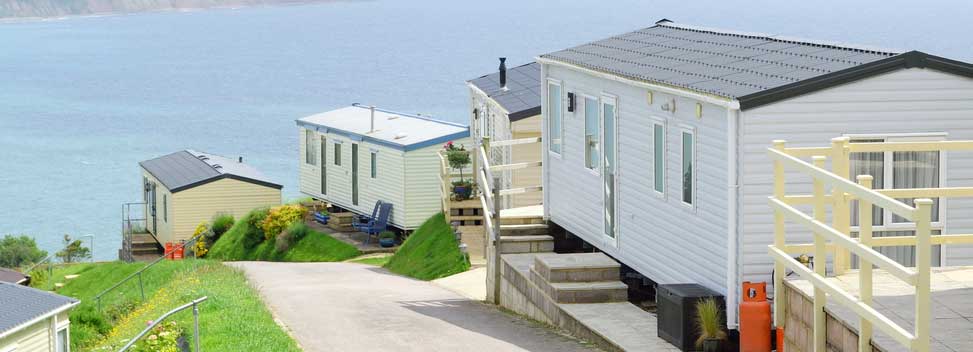Protecting Your Static Caravan from Storm Damage

Understanding storm risks for static caravans
Static caravans are more vulnerable to storm damage than bricks a mortar, due to their lightweight structure and often exposed positioning. Weather that can potential damage a static caravan can include:- High winds can lift poorly anchored caravans.
- Heavy rain may cause leaks, roof damage, or water ingress.
- Flooding is more likely to happen in low-lying or coastal caravan parks.
- Flying debris such broken branches, signage, or unsecured external items can shatter windows or damage cladding.
- Lightning strikes, while rare, can cause electrical surges that may damage appliances, wiring, and solar setups. Static caravans with external aerials or metal-framed structures are particularly vulnerable.
How can I protect my static caravan from storm damage?
Secure the roof and fixtures
Loose roof panels, vents, and aerials are often among the first things to break or become dislodged during high winds. Once damaged, they can cause water ingress and structural damage that can escalate quickly.- Look for cracks, lifting edges, or signs of water staining. Pay close attention to areas around skylights, flues, and ventilation caps.
- Reinforce joins with waterproof sealant where needed. Use caravan-grade sealant and avoid general-purpose silicone, which may degrade in UV or extreme cold.
- Remove unsecured items such as aerials can become airborne in gusts. Either dismantle them before storm season or use reinforced brackets and locking bolts.
Reinforce windows and doors
Windows and doors are more likely to be exposed to wind and flying debris. If damaged, water and wind can penetrate them and could cause damage to the interior and/or electrics.- Fit storm shutters or temporary boarding if severe storms are forecast: Use marine ply or caravan-rated storm panels. Secure with brackets or straps that won’t damage the frame. You could also consider adding glass safety window film.
- Replace worn rubber seals and add foam strips to reduce wind penetration. This also helps prevent damp and heat loss.
- Lock all windows and doors securely before leaving the site. Use multi-point locks where possible. Check that latches are fully engaged and not warped from previous use.
Anchor your caravan properly
Anchoring your static caravan is critical to protecting your static caravan from storm damage. Unanchored caravans can become displaced during storms, causing damage to property and in the worst-case scenario, neighbouring units. Most static caravans have anchor points that can usually be found near the front and rear of the chassis, typically close to the axle stands. Chains are connected from these points to ground anchors, shackles, or spikes embedded in the concrete or gravel base to reduce movement.- Check anchor points annually, and after a major weather event. Look out for rust, lose bolts, or ground movement and always replace worn components, as soon as you can.
- Make sure you're using park-approved anchoring methods. Some sites have specific requirements or offer professional anchoring services, so it’s worth checking that in advance. Following the park’s rules not only keeps your caravan compliant but can also help to ensure your insurance remains valid if you ever need to make a claim.
Clear surrounding hazards
Lightweight items are easily lifted by gusts and even small items can potentially shatter caravan windows or puncture cladding:- Trim trees and shrubs near your pitch. Remove dead and loose branches, and overhang. You could also ask your park manager to trim trees if you feel work is needed beyond your pitch boundary.
- Store outdoor items indoors or in a secure shed. Chairs, bins, and BBQs should be locked away or weighted down.
- Remove any temporary structures like gazebos or awnings. These are not fit to withstand storms and can collapse or fly away, causing damage to your caravan or others nearby.
Install weather alerts
Not getting caught out by fast-moving weather systems is also key to protecting your static caravan from storm damage. Being informed about weather events early gives you time to act. Get ahead by:- Using the Met Office app or signing up for caravan park alerts. These allow you to set up location-based warnings and check for weather updates
- Set up SMS or email notifications for your location. Services like Floodline or Weather & Radar offer tailored alerts for your postcode.
- React early to yellow or amber warnings. Don’t wait for red alerts. Start the process of securing your caravan as soon as you know a storm is on the way.
Caravan storm protection tips for seasonal visits
If you leave your caravan unattended during the off-peak season, it’s vital to prepare it for prolonged exposure to weather.- Drain water systems to prevent burst pipes: Use antifreeze in toilet systems and ensure tanks are fully emptied. Read out article on how to winterise your static caravan for further pointers.
- Disconnect power and gas supplies: Turn off mains connections and isolate LPG bottles. This reduces fire risk and protects appliances.
Maintenance checklist for storm protection
Use this checklist monthly, but especially from September to March, when storms are more frequent:- Inspect roof, windows, and seals for wear or leaks
- Check anchor points for corrosion or movement
- Clear gutters and drainage channels to prevent overflow
- Remove or secure outdoor items and temporary structures
Insurance Considerations
Evidence matters when you need to make an insurance claim. Insurers often request proof of the preventative measures you have in place, so here are some ways you can demonstrate what you have put in place:- Take photos of your caravan before the storms. Include wide shots and close-ups of vulnerable areas. Remember to date them.
- Keep receipts for any protective equipment you have purchased, such as window safely protection film. This will show you have investment in risk reduction
- Record your maintenance checks and anchoring inspections. Use a logbook or app to track check dates, finding and follow up action you undertook.
Frequently asked questions
-
What is the best way to protect a static caravan from storm damage?
Anchoring with storm straps, sealing windows and roofs, and clearing surrounding hazards are key steps.
-
Do I need special insurance for storm damage to my caravan?
Most static caravan insurance policies cover storm damage but check for exclusions and anchoring requirements.
-
How do I secure my caravan during high winds?
Ensure it is well anchored, lock all windows and doors, and remove loose outdoor items.
-
What maintenance should I do before storm season?
Inspect seals, check anchors, clear gutters, and review your insurance policy so you know what you are covered for, if the worse should happen.
-
Can I claim for storm damage if my caravan wasn’t anchored?
No, storm damage is not covered if the property is not been suitably anchored.
The sole purpose of this article is to provide guidance on the issues covered. This article is not intended to give legal advice, and, accordingly, it should not be relied upon. It should not be regarded as a comprehensive statement of the law and/or market practice in this area. We make no claims as to the completeness or accuracy of the information contained herein or in the links which were live at the date of publication. You should not act upon (or should refrain from acting upon) information in this publication without first seeking specific legal and/or specialist advice. Arthur J. Gallagher Insurance Brokers Limited trading as Intasure accepts no liability for any inaccuracy, omission or mistake in this publication, nor will we be responsible for any loss which may be suffered as a result of any person relying on the information contained herein.
